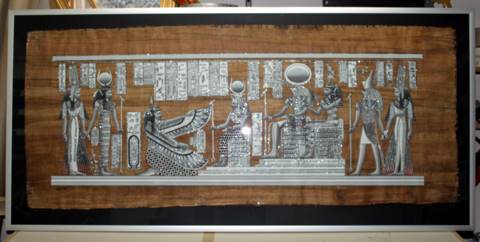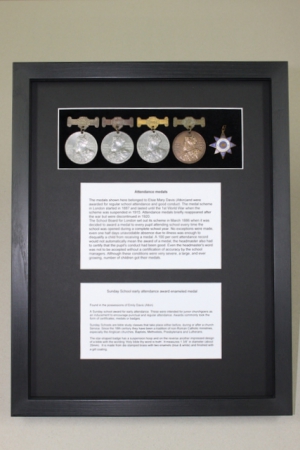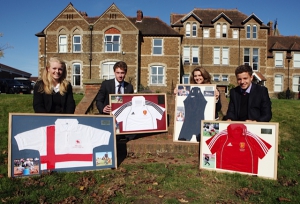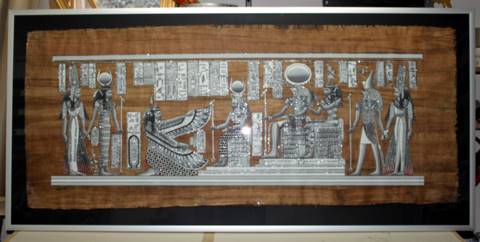Tips and Hints

Andy Parks
Reglazing pictures with broken glass
Broken glass is something that often happens with picture frames. Therefore replacing broken glass is a task that is often performed by picture framers. Glass is a wonderful product and allows your pictures to be displayed as well as kept clean and dust free. However it is often only 2mm or 1/8" thick and is a very fragile product. Glass is quite easily broken with relatively small amounts of pressure applied, especially at the edges of the glass. Some of the more popular reasons for replacing broken glass in customer's picture frames are damage caused during moving home or pictures falling off of walls because of unsuitable hangings or hooks in the wall. Wire can also fray over a period of time and string can also snap but this usually takes quite a number of years. The best thing to do is to take the picture frame straight to a picture framers so they can assess how much of the frame can be saved. You can put sellotape over the cracked pieces of glass but be VERY careful not to cut yourself on any exposed sharp edges of the glass. Also do not turn the frame upside down to see what has happened on the back of the frame as the glass may drop out of the frame. Also if there are loose pieces of glass in the frame be careful about moving the picture frame around too much as you may scratch the picture. Splinters can be very painful and be sure to vacuum clean around the area especially if you have pets as the splinters can get in their paws.
Quite often it may just be the glass that needs replacing. Sometimes it can be a whole new frame as the old frame is just too badly broken. If the old frame was of particular value or one of a set then it may be possible to repair but be aware that the time taken to repair a frame can often mean that it is just as much money to buy a new frame. Another consideration might be to renew the backing and the over mount. There are far better conservation products now available on the market and whilst the picture is out of the frame it may be worth considering materials that will help to preserve your picture. Please pardon the pun but it is literally a pain when glass breaks in picture framing but please do be careful when handling any broken picture framing glass.
Medals - not just Olympic!
We are often asked to frame medals and with the recent medal rush by Team GB at the Olympics I thought it might be an interesting topic to cover especially as we have recently framed a set of medals for a customer. I haven't as yet framed an Olympic Medal but I have framed London Marathon Medals so I may change this blog accordingly in the future!
The first issue with framing medals concerns whether they will ever be worn again. If so, the frame will need a removable back. Also the medals will need to be easily removed from the frame itself. This is fairly easy to achieve and was a recent project for a retired Admiral where he needed to wear them at certain military ceremonies. However in this particular case for this blog entry the medals were awarded for school attendance in the early 1900's so the idea was that the finished framed medals combined with text telling the story behind the medals would form a permanent display. Medals often look effective on a black background and in this instance the medals were carefully stitched onto black velvet. Then the medals can easily be removed by simply cutting the stitches and thus returning the medals to their original state. This utilises a conservation principle of picture framing where anything that you frame should be easily restored to it's original state. Then the medals were framed using a painted black ash moulding which is deep enough to keep the glass away from touching the medals. Also by using a black over mount any other items such as photographs, certificates or descriptive text can easily be added to the finished frame.
The finished result looks very effective and a great way to display items that might otherwise stay in a draw or box in the loft!
Framing Sports Shirts
We are often asked to frame sports shirts such as cricket, rugby, hockey or football shirts. These are often signed by teams or by famous sporting people and so often will have a significant financial value as well as sentimental. As with so many picture framing tasks, we have to think of this as a conservation picture framing project. Hence the shirts are always 'tacked' lightly to a suitable coloured backing board. Then if needed the framing could easily be reversed to return the shirt to it's original state. The backing board should be a colour that creates a contrast to the colour of the shirt. Then the shirt will really stand out when it is hanging on the wall. If for example a white shirt was framed using a white background the shirt would simply dissappear into the framing and would not look anywhere near as effecive as it could. The glass should also be elevated away from the shirt and so a slightly deeper or even a purpose made box frame may be required. Here are some examples of some sporting shirts recently framed for Churcher's College in Petersfield. The swimming outfit was worn by a student that swam the English Channel. A real achievement and something worth preserving in a frame.
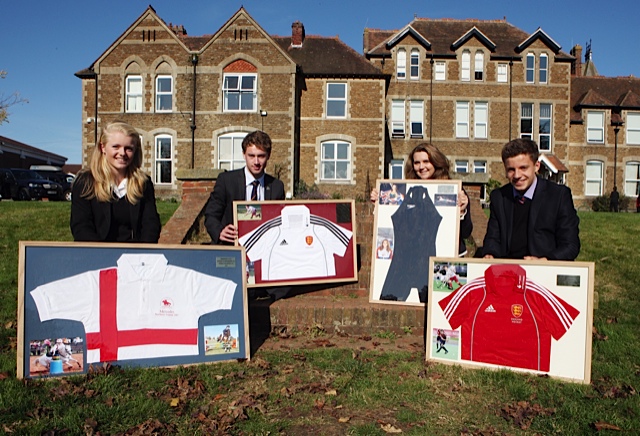

Jigsaw framing
I have framed quite a few jigsaws as a picture framer and some rather interesting subject matter has included Hong Kong Harbour, The Tower Bridge, London and more recently a photo of Alex Stewart with the customer. I always think they are a great picture to frame. Also it seems a pity to break the jigsaw up after you have finished it when you and your friends and family could admire the jigsaw on your wall for at least a while longer. The main problem is how to get the jigsaw into the frame without the puzzle coming apart. As long as you bring the jigsaw into my workshop on a fairly sturdy board I can then dry mount (permanantly attach) the jigsaw onto another board so that the jigsaw will not come apart in the frame or framing process. It can be a good idea to cover the jigsaw with a sheet or newspaper during transit but just make sure you keep it flat and face up during the journey. Failing that, please bring along the lid of the jigsaw box so I can at least have a few clues as to where the pieces might go!
Very large oil paintings on canvas
These are not an every day framing project but are regular enough to warrant a mention on my blog. Quite a few customers have taken a fancy to very large oil paintings whilst they are away on their holidays. I think this is a great idea and a perfect reminder of a wonderful holiday. Often the price of these very large oils is also a contributing factor as they are probably cheaper abroad than they might be here in the UK. Recent oils I have framed have included an elephant from Thailand, a carpet dye market stall in Morocco and a piece of Aboriginal art depicting dreamtime. Rather annoyingly for the customers they have had to have the oils taken off their original stretcher bars and have the oils rolled up in a tube to get them back home (it would be great if you can bring the original stretcher back with you but I appreciate that this might well be impractical). They then need them stretched and framed upon their return. At this point I always recommend a really strong stretcher bar system to keep the oil stretched and flat on the wall even if it is to hang without a frame. The stretcher bars that I use are very strong and the bar needs to have cross members (when the stretcher bar is constructed it will look a little like the square window in 'Play School' for those of you who remember that television program!). OK I admit that this does add a considerable cost to the picture framing bill but this will help to protect your image over the long term by keeping the canvas taught and making sure the oil paint does not pop off the canvas due to folding or creases. As a very wise customer once told me "you only want to frame it once!" Wise words indeed!
Hand painted frames
We have had quite a few orders recently that have chosen hand painted frames. This is always a good choice of frame as the colour of paint used can often exactly match a specific tone or area of the picture to be framed. We usually use a water based paint to ensure the natural grain of the wooden frame will still show through after painting. The finished effect can be further enhanced with the use of various polishes, varnishes or waxes to protect the surface. We often order tins of paint from the various colour charts available (such as Farrow and Ball, Dulux and Crown to name a few) but I am sure a lot of you will know that the colour ordered from the charts is not necessarily a fair representation of the colour received! However a small addition of other colours we already have from previous orders will create the desired effect. We often end up mixing several colours to suit a certain colour which might be in the pictures or even in the customer's curtains! Either way a hand painted frame can create a stunning effect that perfectly complements the picture or the pictures' surrounding decor.
To over-frame or not to over-frame? That is the question!
I have just spent a very interesting afternoon at the London Watercolour and Drawings Fair at the Science Museum, Kensington. There were some amazing pieces of art on display and a showcase of some truly stunning artists. As a general point about most of the framing on display I would say that the choices of materials were very bold as regarding widths and styles of frame. Some pieces are very old and have their original ornate gold frames which is to be expected. This is the correct thing to do if the frame is the original one as this adds to the value of the art and adds to the picture's provenance. However I have always been quite a believer in not 'over-framing' pictures. This means that wide, ornate gold mouldings would probably be one of the last choices on a small subtle watercolour and yet there were plenty of examples of this type of frame in use. I discussed this with several of the exhibitors there and they put across their reasons for using this type of frame as keeping with tradition and a more ornate style of framing actually adding to the overall impact of the work of art. I must say that the framing did look very impressive all together in one display when all those frames were heavy ornate frames. However I wonder if the same could be said when each piece of art would be hanging on it's own in a new home? I think that if you are looking at the frame before you are looking at the artwork you have probably made the wrong choice of framing materials. Nothing that I saw today has changed this belief. However there would seem to be a place for more substantial framing if only for older style paintings? An interesting debate that I am sure will continue for a long time to come. The London Watercolour and Drawings Fair continues at the Science Museum, Kensington until Sunday 5th February 2012.
Unusual map of the United Kingdom
I think that maps are a great thing to have on your wall. Along the corridor to our workshop we have an OS map centred on the Buriton Business Park, a 19th Century reproduction map of Hampshire by Thomas Moule and a modern map of the world. I always find them fascinating to look at and you can never know enough about the planet or your home town geographically. However a company has come up with the idea of producing maps made up of entirely text with the text relating to that area of the map. For example part of Devon has the words "cream teas" forming part of that county. Our particular area of Hampshire has the words Jane Austen forming part of the county. As with so many frames it is important not to over frame the picture and so a simple oak frame with a light green mount to match the customer's decor was chosen. The poster was also "dry mounted" onto a thicker sheet of mount board to prevent the poster cockling up in time due to changes in temperature. Please visit the Snow Home website for more details. The idea is a brilliant one and I liked it so much I have ordered one to go along my corridor!
Favourite books on one poster
We do see some very clever art that is framed at our workshop. A poster came in recently that had the ingenious idea of putting the text of your favourite book onto one A1 sized poster. Of course the text size is very small but remains readable. However the really clever part is the use of cut outs of text to create shapes associated with that book. The poster that we framed was of the book Alice in Wonderland where the cut out areas were of a little girl and the suits of a pack of playing cards hearts, diamonds, clubs and spades. Other books include Black Beauty with the text all in the horse's head and A Christmas Carol with the cut out of a candle. The effect created from a distance is stunning and a perfect tribute to your favourite book. The text is in black by default and so a very simple white over mount was used and then a 1.25" or 30mm square black profile to frame the poster. A truly stunning and very creative idea. In fact I liked the idea so much I bought my partner Janet one for a present. She is a RE teacher and so I bought her The Bible where the cut out area is a hand offering an apple! For more information please visit the Spineless Classics website.
6 feet Papyrus Painting!
One of the largest papyrus paintings I have ever seen came into the workshop this week. It measures over 6 feet or 1.8 metres in length. This size of picture always creates some challenges for a picture framer as this is longer than most sheet materials, such as the glass or the mount board to display the papyrus on. However, with a suitable colour emulsion paint, any backing board large enough can be transformed into the desired effect. In this case the backing board was painted black to show off the papyrus to the best effect. Also the papyrus was mounted on top of the black board to make a feature of the unfinished edges of the papyrus.
